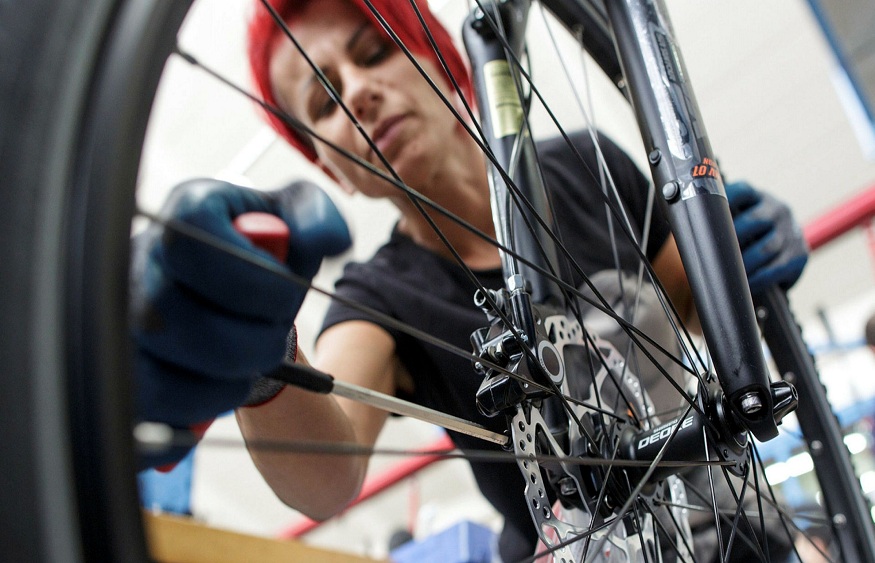In the world of cycling, we often talk about “transmission”. It seems obvious to us, but “ the obvious can maintain ignorance ”. So we decided to tackle transmission in our “word of the day” section.
Who is it ? What consequences are linked to the choice of transmission? How to pay attention to it? How to maintain it?
Transmission: attempts to define
The magic of cycling is to transform a human’s energy into movement. Transmission is the magic wand. Despite its great simplicity, this mechanism has survived the ages without major substantive changes, guaranteeing an effective design.
What does this ingenious system consist of? Starting from the greenest motor, you and two pedals, the ” cranks ” placed on a ” pedal ” drive a chain or a belt. The chain comes to turn around a gear called ” pinion “. In turn, the pinion fixed to the hub of the rear wheel produces the rotation of the latter. This simple system was enhanced by the marvelous invention of the “ derailleur ” which, as its name suggests, sends the chain to other rails (other sprockets) in order to modify the pedaling “ gear ”.
The transmission is thus all the parts that allow your legs to move the bike forward. Among these parts we can count: the crankset, the pedals, the chain, the sprockets. Shift levers, front and rear derailleurs, cassette, bottom bracket can also fall into the category. When we talk about “transmission” as a selling point, we will rather talk about the quality of the shift levers and the front and rear derailleurs.
What importance should be given to the choice of transmission?
When you buy a bike that has a “better drivetrain”, you ensure yourself of several consequences.
First, satisfaction during use.
Your enjoyment when it comes to transmission comes from comfort and efficiency. With better levers, you get more precise shifting. With a better rear derailleur, this precision translates into greater efficiency: the chain goes up better and goes down better on the sprockets. With a better transmission, you get more durable parts, meaning the quality of those shifts will be consistent for longer.
Second, reliability.
A better transmission remaining more constant over time, you will thus gain in reliability. What could be more unpleasant when you are a little late in the morning than having to “pick up” your chain to put it back on its sprockets? It’s dirty, it’s boring… You don’t want that.
Having a Shimano XTR derailleur does not necessarily prevent ” derailment ” but the chances of it happening are still lower than with an entry-level derailleur.
What interview?
One of the two duties of the cyclist towards his mount is to lubricate his chain. The second is to keep your tires at the right pressure.
How to lubricate the chain? Opt for an oil specially designed for this. Choose from more or less viscous products. A fatter, thicker lubricant lasts longer and lubricates in depth. You will use this kind of lubricant if you don’t want to repeat the process too often. If you drive all year long, never be stingy with oil and above all, prefer the most viscous.
More liquid lubricants are interesting because they aggregate less dirt on the transmission. However, they disappear faster. It is therefore necessary to repeat the operation very often for urban use.
Apply oil to the chain and rotate the cranks several turns while pedaling backwards. Thus you apply the oil on the whole chain. Change gears to ensure gear lubrication. Finally, pass a rag by turning the cranks back again. This removes excess and keeps your transmission cleaner longer.
C assette: a cassette is a set of sprockets that you “slide” on an axle called “cassette body”. The bearings (the bearing balls) are located in the cassette body. Thus, these are many different parts that act together. This increases efficiency, allows weight gain, more or less rigidity, etc. Technologies and mechanics that give you more quality, more durability than a freewheel.
Free wheel: the principle of the pinions, but not detaching from each other. The freewheel is a block that is screwed onto the hub. The freewheel bearing (the bearing balls) are part of the block.
Chain : set of links “connecting” the crankset to the sprockets. A chain wears out: it must be changed regularly. The longer you let a chain wear out on your bike, the more your drivetrain wears out. It is simpler and less expensive to change just one chain than the “chain, cassette, crankset” transmission. Because all this wears out in the family, but not at the same speed. The chain wears faster than the cassette, and the cassette wears faster than the chainrings. There are chains of different widths: a 10-speed chain is not as wide as an 8-speed chain, but not as narrow as an 11-speed chain. Chain compatibility is essential for your transmission to work at its best.
D erailleurs: derailleurs are used to change gears. You don’t necessarily go faster or slower. On the contrary, when we talk about gear change, we are rather talking about a change of gear ratio or pedaling ration. Derailleurs also have their compatibility rules: you can use a 10-speed derailleur for a 9 cassette, but the reverse is not true!
Crankset : The crankset is the part holding the cranks, pedals and chainrings together. Placed on a bottom bracket, it is the “wheel” that turns and transmits your physical force to the chain and the wheels. It is by turning the crankset that you move forward.
